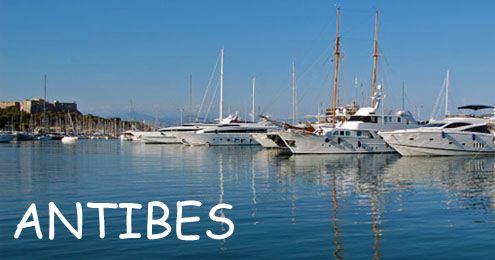WELCOME TO ANTIBES
Learn French this summer in beautiful Antibes.
Antibes-Juan les Pins is one of the most well known resorts on the Côte d'Azur, located between Nice (20 km) and Cannes (12km). Antibes manages to be a historic town, an eventful town and also an innovating town, easily mixing these multiple facets.
Beaches
The Fort Carré
The rocky beaches of Antibes
aerial viewThere are 48 beaches along the 25 km of coastline that surround Antibes and Juan les Pins.
Museums
Archaeology Museum - This museum sits atop the Promenade Amiral de Grasse in the old Bastion St Andre, a 17th century fortress. The museum's collection focuses on the classical history of Antibes. Many artifacts, sculptures and amphorae found in local digs and shipwrecks from the harbour are displayed here. The views of the sea and mountains from the promenade are also spectacular.
Naval Museum of Napoleon - Housed in a 17th century stone fort and tower, this museum presents a collection of Napoleonic memorabilia, paintings and naval models. Several wall paintings show historic moments in Napoleon's reign and there are also pieces of his clothing such as one of the hats he once wore.
Picasso Museum - This museum houses one of the world's greatest Picasso collections: 24 paintings, 44 drawings, 32 lithographs, 11 oils on paper, 80 pieces of ceramics, 2 sculptures and 5 tapestries.
La Tour Museum - This small museum in the centre of town brings the contemporary history of Antibes to life through its exhibit of costumes, tools, photographs and other objects used by the local people.
Absinthe Museum - From its basement location within the Roman foundations of Old Antibes, the Absinthe Museum is a must-see for any visitor to Antibes. The owners and their staff are happy to talk you through the process and teach you to appreciate the distinctly green liqueur like a fine wine.
Parks and Gardens
The Exflora Park is a five hectare garden open to the public. Next to the large olive grove, there are different styles of Mediterranean gardens, from ancient Rome to the exuberant Riviera of the 19th century. Fountains and ponds stretch along the terrace, making a waterway 500m long. Antibes is renowned for rose production, and rose bushes line the path leading to the sea. The luxuriance of the exotic garden and palm grove is reminiscent of the belle époque, when English gardeners succeeded in planting flowers that bloom in winter, the season when the aristocracy visited the Côte d'Azur.
A little further on is the Théâtre de Verdure, inspired by Italian gardens, and a panoramic viewpoint with a glorious view of the sea and the Iles des Lerins. In the style of Provençal gardens of the 18th century, there is a maze with sculpted hedges. Further on, Islamic gardens are featured, with an orange grove where the ground is patterned with terracotta irrigation pipes similar to those in the celebrated Seville Cathedral in Spain.
The vegetable gardens and orchards in the Arsat are planted in hollows as in Morocco to protect them from the sun and maximise shadow and humidity. A representation of a Moroccan house pays homage to the painter MAJORELLE, creator of the beautiful blue garden in Marrakesh. In another area, the winter garden contains plants that flower in winter, such as mimosa and camellias.
The Eilenroc Gardens
Villa Eilenroc was built on a rock in the middle of a virtual desert. The area was transformed into a glorious garden through the patience and talent of Jacques Greber, landscape architect and consultant to the Great Exhibition in New York in 1939. He was commissioned by Mr Beaumont to create this luxuriant park of 11 hectares.
The gardens with all their luxuriant vegetation lie thirty metres above the sea with a view across the bay of the Cap. Planted with traditional mediterranean species such as marine and parasol pines, Alep and Canary pines, Cyprus, oaks, olive trees, arbutus, lavender, thyme, rosemary, eucalyptus, ficus, etc., as well as three km of pittosporum hedges, a whole part of the park has been created with plants found in the Antibes area in 1920.
Thuret Park
In 1857, Gustave Thuret discovered the wonderful, unspoilt Cap d'Antibes and bought five hectares of land where he built a villa and began the creation of a glorious park. Bequeathed to the state by his heirs, the Jardin botanique de la Villa Thuret is now managed by the INRA (National Institute of Agronomic Research). The superb collection of trees and exotic plants, and the rich earth, provide many opportunities for learning, and the cross-fertilisation of plant species that grow on the mediterranean coast.
Garoupe Lighthouse
The old lighthouse of Antibes provides one of the best views in the region from its lofty hilltop. To get here, you must walk about one kilometre up the Chemin de Calvaire from the Plage de la Salis. It makes for a nice half-day stroll.
Church of the Immaculate Conception
The central church in Antibes was first built in the 11th century with stones used from earlier Roman structures. Its current façade was constructed in the 18th century and blends Latin classical symmetry and religious fantasy. The interior houses some impressive pieces such as a Baroque altarpiece and life-sized wooden carving of Christ's death from 1447.
Hôtel du Cap-Eden Roc
This villa, set in "a gorgeous forest" at the tip of the Cap d'Antibes peninsula, re-creates a nineteenth-century château. Since 1870 the glamorous white-walled Hotel du Cap on the French Riviera has been one of the most storied and luxurious resorts in the world. Guests who flocked there included Marlene Dietrich, the Duke and Duchess of Windsor and Winston Churchill. Elizabeth Taylor and Richard Burton conducted an affair and honeymooned there.
Ports
There are many yachting harbours which provide moorings for a range of ships ranging from fishing vessels to full sized yachts.
Port Vauban:
The largest yachting harbour in Europe, with more than 2,000 moorings, can accommodate craft of more than 100 metres. This old port was the heart of the ancient Greek city of Antipolis and has a long and colourful history which includes Ligurians, Romans and Crusaders on their way to the Holy Land. Today, it is the largest marina in Europe, serving both local fishing boats and luxury yachts.
Theatre and music
The Theatre Antibea, Theatre des Heures Bleues and Café Theatre La Scene sur Mer all offer a variety of performances from orchestra music to dramatic plays. Music of all types, from live jazz to DJs spinning techno, can be found in the bars and nightclubs and there are a number of festivals and special outdoor concerts during the summer. Jazz is still the specialty around here, and the Juan les Pins Jazz Festival is one of the best in the world.
Festivals
Antibes and Juan les Pins host a number of festivals, mainly during the summer months. There's not much in the way of traditional cultural festivals in Antibes; most of the festivals focus on music and contemporary activities.
Jazz à Juan remains one of the top jazz festivals in the world. Since its inception in 1960, it has attracted many famous Jazz artists each year to play outdoors.(July).
Antibes Yacht Show




